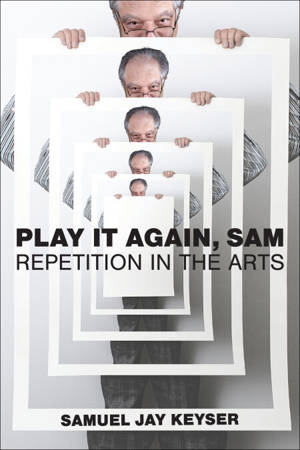
- Afhalen na 1 uur in een winkel met voorraad
- Gratis thuislevering in België vanaf € 30
- Ruim aanbod met 7 miljoen producten
- Afhalen na 1 uur in een winkel met voorraad
- Gratis thuislevering in België vanaf € 30
- Ruim aanbod met 7 miljoen producten
Zoeken
€ 29,56
+ 29 punten
Omschrijving
Why we enjoy works of art, and how repetition plays a central part in the pleasure we receive.
Leonard Bernstein, in his famous Norton Lectures, extolled repetition, saying that it gave poetry its musical qualities and that music theorists' refusal to take it seriously did so at their peril.
Play It Again, Sam takes Bernstein seriously. In this book, Samuel Jay Keyser explores in detail the way repetition works in poetry, music, and painting. He argues, for example, that the same cognitive function underlies both how poets write rhyme in metrical verse and the way songwriters like Duke Ellington and Billy Strayhorn (“Satin Doll”) and Richard Rodgers and Lorenz Hart (“My Funny Valentine”) construct their iconic melodies. Furthermore, the repetition found in these tunes can also be found in such classical compositions as Mozart's Rondo alla Turca and his German Dances, as well as in galant music in general.
The author also looks at repetition in paintings like Gustave Caillebotte's Rainy Day in Paris, Andy Warhol’s Campbell's Soup Cans, and Jackson Pollock’s drip paintings. Finally, the photography of Lee Friedlander, Roni Horn, and Osmond Giglia—Giglia's Girls in the Windows is one of the highest-grossing photographs in history—are all shown to be built on repetition in the form of visual rhyme.
The book ends with a cognitive conjecture on why repetition has been so prominent in the arts from the Homeric epics through Duke Ellington and beyond. Artists have exploited repetition throughout the ages. The reason why is straightforward: the brain finds the detection of repetition innately pleasurable. Play It Again, Sam offers experimental evidence to support this claim.
Leonard Bernstein, in his famous Norton Lectures, extolled repetition, saying that it gave poetry its musical qualities and that music theorists' refusal to take it seriously did so at their peril.
Play It Again, Sam takes Bernstein seriously. In this book, Samuel Jay Keyser explores in detail the way repetition works in poetry, music, and painting. He argues, for example, that the same cognitive function underlies both how poets write rhyme in metrical verse and the way songwriters like Duke Ellington and Billy Strayhorn (“Satin Doll”) and Richard Rodgers and Lorenz Hart (“My Funny Valentine”) construct their iconic melodies. Furthermore, the repetition found in these tunes can also be found in such classical compositions as Mozart's Rondo alla Turca and his German Dances, as well as in galant music in general.
The author also looks at repetition in paintings like Gustave Caillebotte's Rainy Day in Paris, Andy Warhol’s Campbell's Soup Cans, and Jackson Pollock’s drip paintings. Finally, the photography of Lee Friedlander, Roni Horn, and Osmond Giglia—Giglia's Girls in the Windows is one of the highest-grossing photographs in history—are all shown to be built on repetition in the form of visual rhyme.
The book ends with a cognitive conjecture on why repetition has been so prominent in the arts from the Homeric epics through Duke Ellington and beyond. Artists have exploited repetition throughout the ages. The reason why is straightforward: the brain finds the detection of repetition innately pleasurable. Play It Again, Sam offers experimental evidence to support this claim.
Specificaties
Betrokkenen
- Auteur(s):
- Uitgeverij:
Inhoud
- Aantal bladzijden:
- 308
- Taal:
- Engels
Eigenschappen
- Productcode (EAN):
- 9780262383127
- Verschijningsdatum:
- 26/05/2025
- Uitvoering:
- E-book
- Beveiligd met:
- Adobe DRM
- Formaat:
- ePub

Alleen bij Standaard Boekhandel
+ 29 punten op je klantenkaart van Standaard Boekhandel
Beoordelingen
We publiceren alleen reviews die voldoen aan de voorwaarden voor reviews. Bekijk onze voorwaarden voor reviews.











